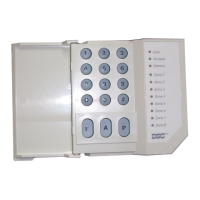
Do you have a question about the DSC PC1555MX and is the answer not in the manual?
| Model | PC1555MX |
|---|---|
| Keypads | Up to 8 |
| Communication | Built-in telephone line communicator |
| Power Supply | 16.5 VAC, 20/40 VA transformer |
| Battery Backup | 12V 4AH |
| Compatibility | Compatible with DSC wireless devices |
Vital information for installers to convey to users about system limitations and potential failures.
Details on various reasons why a security system might fail or not operate as expected.
Proper installation is crucial for system effectiveness; professional evaluation is recommended.
Potential for criminals to develop methods to reduce system effectiveness over time.
How intruders might bypass points, evade detection, or disable the system.
System devices require adequate power; interruptions can cause damage or malfunction.
Wireless device battery life varies; low battery monitors may fail, requiring regular testing.
Wireless signals can be affected by metal objects or deliberate jamming.
Users must be trained on correct operation and emergency response procedures.
Limitations of smoke detectors in alerting occupants to different fire types or locations.
Limitations of motion detectors, including detection areas and environmental factors.
Limitations of audible/visual warning devices regarding walls, noise, and hearing impairment.
Potential for telephone lines to be out of service, busy, or cut by intruders.
Occupants may not be protected due to insufficient time to respond to alarms.
Despite efforts, system components may fail, leading to malfunction.
Regular testing is vital to find problems; includes weekly tests and post-event checks.
Alarm system is not a substitute for property/life insurance or prudent practices.
Warranty terms for international customers, excluding customs fees.
Steps to follow to obtain warranty service, including authorization numbers.
Factors that will void the product warranty, such as misuse or unauthorized alterations.
Specific items or costs not covered by the warranty, like freight or disassembled products.
States that the provided warranty is the only one and excludes implied warranties.
Procedures and charges for repairing or replacing products outside the warranty period.
System's capability to monitor fire detectors and provide warnings.
Emphasizes the need for weekly system testing for continued proper operation.
System's ability to send alarms to a monitoring station and the importance of calling them.
Overview of system components like control panels, keypads, and sensors.
Security systems do not prevent emergencies and require professional installation/service.
FCC compliance details, including product identifier and connection requirements.
Details on connecting the equipment to the telephone network using compliant jacks.
Explains REN and its importance for determining the number of devices on a phone line.
Procedures if the equipment causes harm to the telephone network, including FCC complaint rights.
How telephone company changes might affect equipment and the need for advance notice.
Contact information for repair or warranty information for the equipment.
Notes on party line service, state tariffs, and alarm dialing equipment connection.
Sections to record master code, additional access codes, and zone details.
Guidance on creating and rehearsing a family escape plan for fire emergencies.
Guidelines for routine system upkeep and component replacement.
Steps to disarm the system using different keypad types.
Procedure to bypass zones using different keypad types to allow arming.
How to view and understand system trouble indicators on the keypad.
Information on using and managing system access codes.
Instructions for arming the system using LED or LCD keypads.
Procedures for performing alarm tests and full system tests.
How to activate and use the door chime feature on keypads.
Instructions for programming master and additional access codes via LCD keypad.
Guidance on responding to fire, intrusion, and other alarm types.
Explanation of function keys for common system operations (e.g., Stay, Away).
Procedures for programming master and additional access codes via LED keypad.
Explanation of system busy status and various indicator lights on keypads.
Function of Fire, Auxiliary, and Panic keys on PC1555RKZ keypad.
Function of emergency keys on LCD keypads.
Instructions for setting the system's date and time.
Details on how the system responds to a fire alarm.
Procedure for resetting smoke detectors after an alarm.
Guidance for conducting a fire safety audit at home.
